The Great Pyramid of Khufu in Giza is arguably the most famous of all pyramids in Egypt, or in the world for that matter. Yet, this was not the first pyramid that was built by the ancient Egyptians. An earlier Egyptian pyramid was built 4,700 years ago in Saqqara for a 3rd Dynasty pharaoh Netjerikhet, commonly known as Djoser. After 90 years of waiting, visitors to Saqqara can now venture inside the ancient structure popularly known as the Step Pyramid!
Open to the Public!
The last time the pyramid was opened to tourists was in the 1930s. It was closed due to concerns that the structure was unsafe. But the restoration project began in 2006 to try to make entrance into this iconic Saqqara monument available again to the public. Despite work being put on hold between 2011 and 2013, the outer facades, stairs, two entrances, internal corridors to the burial chamber and the stone sarcophagus have all been conserved.
Cintec, the Welsh company that repaired the pyramid, reported that the work was not easy or safe, “It really was extremely, extremely, dangerous,” Peter James, the company’s Managing Director, told The Times . According to Daily Mail , “Rubble had dropped onto the sarcophagus from the roof and many supporting internal stone beams had broken.” There was even concern that the engineers working inside could have caused the pyramid to collapse on them while they were working.
Imhotep’s Innovative Step Pyramid at Saqqara
The original architect responsible for the design and construction of the pyramid was none other than Imhotep, who served as Djoser’s chancellor. The most noticeable difference between Djoser’s pyramid and that of Khufu is the shape of each structure. Unlike the Great Pyramid , Djoser’s pyramid consisted of six steps, similar to the ziggurats of the ancient Mesopotamian city states, and thus was commonly known as the Step Pyramid of Saqqara.
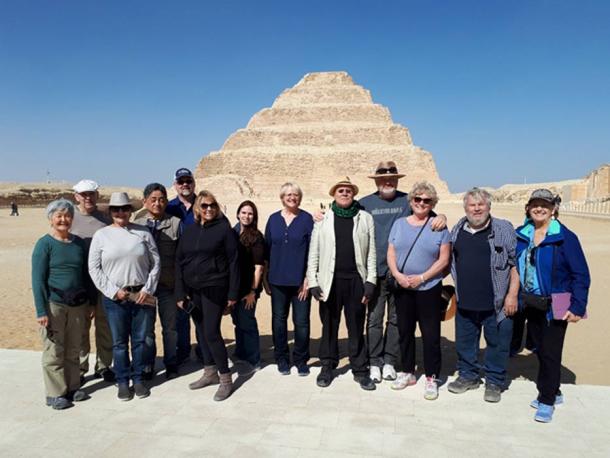
Ancient Origins Tours visited Egypt in February 2020. Here is the happy tour family: Lou, Richard, Marcie, Ken, Brian, Luminous, Alicia, Faye, Andrew, Steve, Aila, Lisle, and Mary Lou in front of Djoser’s pyramid. (Image: Alicia McDermott)
The unique shape of Djoser’s pyramid may be explained by looking at the building structures that were in use prior to the construction of pyramids in ancient Egypt. During Egypt’s Early Dynastic Period and Old Kingdom, rectangular structures with a flat roof and outward sloping sides were used to mark the tombs of the elite members of society. These structures, made of mud-brick or stone, were known as mastabas (meaning ‘bench of mud’ in Arabic).
Perhaps intending to outdo his predecessors, Djoser decided to stack six mastabas, each of a decreasing size, on top of each other, thus producing the Step Pyramid. The construction of the Step Pyramid may have been a reflection of the evolution of the understanding of Egyptian kingship, as the structure could also be interpreted as a means to facilitate the king’s ascension into the divine realm after his death.
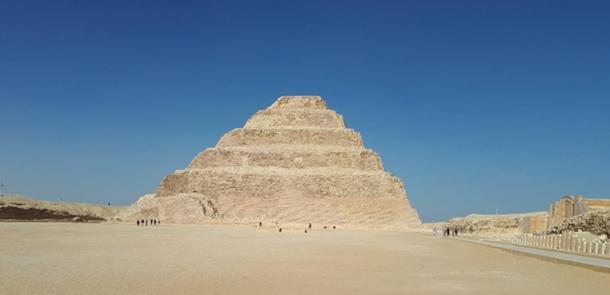
The Step Pyramid, Saqqara. (Image: Alicia McDermott)
An Ancient Egyptian Architectural Marvel
Regardless of the reason for this innovation, the Step Pyramid was an architectural marvel of its time. At a height of about 62 meters (203.41 ft.), the Step Pyramid dominated the landscape of the Saqqara necropolis . Nevertheless, the pyramid was only part of a larger mortuary complex that served to perpetuate the cult of the pharaoh. The entire complex, which covered an area of 15 hectares, was surrounded by a wall of light Tura limestone 10.5 meters (34.45 ft.) high.
14 walls can be found along the wall circuit, though only one entrance (located on the south end of the east façade) was accessible to the living. This entrance is connected to the South Court via a roofed colonnade. The columns of this passage were made of limestone carved to resemble bundles of plant stems.
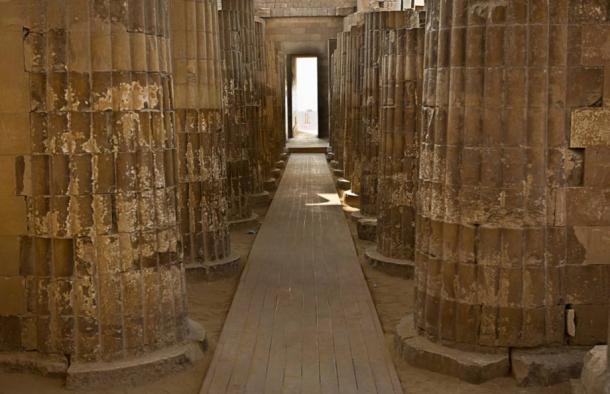
The colonnade at Saqqara. (Image: BigStockPhoto)
As for the Step Pyramid itself, its entrance is located in the north side of the structure. Djoser’s mortuary temple can also be found on this side of the pyramid. This temple served as the cult centre for Djoser’s divine ka. It was in this temple that the daily rituals for the dead could be performed, and offerings could be presented to the pharaoh in the afterlife. It may also be pointed out that the mortuary temple faced north as it was believed that the pharaoh would become one of the eternal stars in his afterlife.
In the South Court are curved stones thought to be boundary markers associated with the Sed Festival, an important rejuvenation ritual performed by the pharaoh after reigning for 30 years. It has been suggested that the presence of these markers was meant to allow Djoser to continue benefitting from the ritual even in the afterlife.
As for the Step Pyramid itself, its entrance is located in the north side of the structure. Djoser’s mortuary temple can also be found on this side of the pyramid. This temple served as the cult center for Djoser’s divine ka. It was in this temple that the daily rituals for the dead could be performed, and offerings could be presented to the pharaoh in the afterlife . The mortuary temple faced north as it was believed that the pharaoh would become one of the eternal stars in his afterlife.
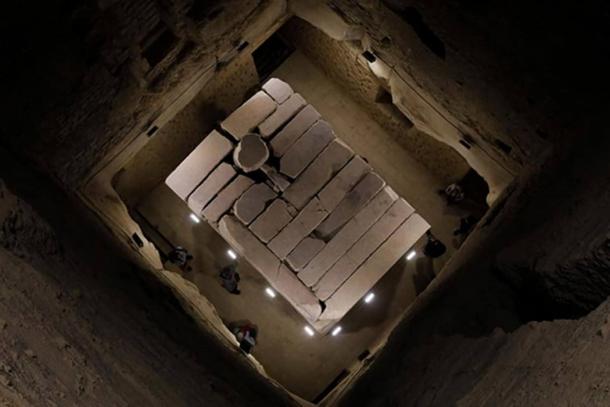
Looking down at the burial chamber and sarcophagus inside the newly renovated Djoser pyramid. (Image: Ministry of Tourism and Antiquities )
Criticisms Didn’t Stop the Restoration of Djoser’s Pyramid
The Step Pyramid has stood for over four and a half millennia, despite being constantly battered by the elements. For years, attempts were made to restore and conserve this ancient structure. These attempts, however, came under criticism.
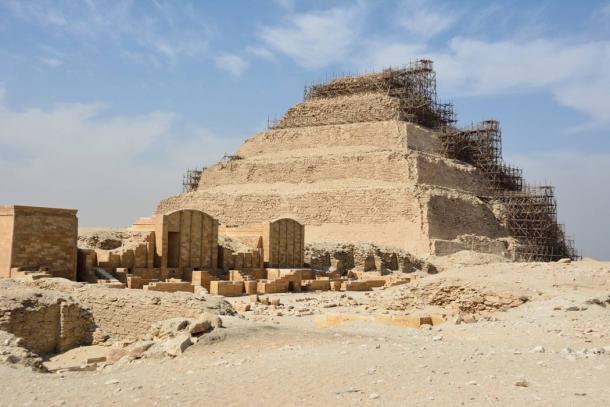
The pyramid being restored. (Image: bernd_fuelle /Adobe Stock)
According to critics, the restoration work has drastically altered the way the outside of the pyramid looked. Concerns were also raised that the inside of the structure would be altered. These claims have been denied by the Egyptian authorities, and restoration work on the pyramid was allowed to continue. Thankfully the efforts have now made it safe and possible for visitors to Egypt to see the inside of this amazing monument built so long ago.
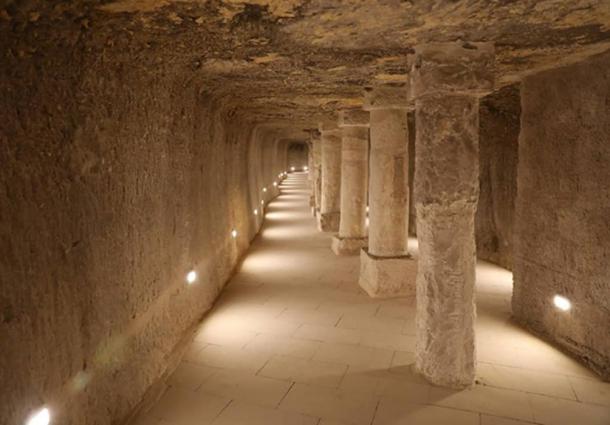
Inside the newly restored Djoser pyramid. (Image: Ministry of Tourism and Antiquities